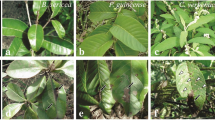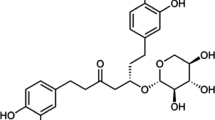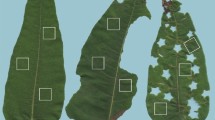Abstract
We studied the effect of epidermal leaf mining on the leaf chemistry of quaking aspen, Populus tremuloides, during an outbreak of the aspen leaf miner, Phyllocnistis populiella, in the boreal forest of interior Alaska. Phyllocnistis populiella feeds on the epidermal cells of P. tremuloides leaves. Eleven days after the onset of leaf mining, concentrations of the phenolic glycosides tremulacin and salicortin were significantly higher in aspen leaves that had received natural levels of leaf mining than in leaves sprayed with insecticide to reduce mining damage. In a second experiment, we examined the time course of induction in more detail. The levels of foliar phenolic glycosides in naturally mined ramets increased relative to the levels in insecticide-treated ramets on the ninth day following the onset of leaf mining. Induction occurred while some leaf miner larvae were still feeding and when leaves had sustained mining over 5% of the leaf surface. Leaves with extrafloral nectaries (EFNs) had significantly higher constitutive and induced levels of phenolic glycosides than leaves lacking EFNs, but there was no difference in the ability of leaves with and without EFNs to induce phenolic glycosides in response to mining. Previous work showed that the extent of leaf mining damage was negatively related to the total foliar phenolic glycoside concentration, suggesting that phenolic glycosides deter or reduce mining damage. The results presented here demonstrate that induction of phenolic glycosides can be triggered by relatively small amounts of mining damage confined to the epidermal tissue, and that these changes in leaf chemistry occur while a subset of leaf miners are still feeding within the leaf.




Similar content being viewed by others
References
Agrawal, A. A., Strauss, S. Y., and Stout, M. J. 1999. Costs of induced responses and tolerance to herbivory in male and female fitness components of wild radish. Evolution 53:1093–1104.
Bentley, B. L. 1977. Extrafloral nectaries and protection by pugnacious bodyguards. Annu. Rev. Ecol. Systemat. 8:407–427.
Bingaman, B. R., and Hart, E. R. 1993. Phenolic glycosides and host selection behavior of Chrysomela scripta (Coleoptera: Chrysomelidae). Environ. Entomol. 22:397–403.
Bokalo, M., Comeau, P. G., and Titus, S. J. 2007. Early development of tended mixtures of aspen and spruce in western Canadian boreal forests. For. Ecol. Manage. 242:175–184.
Bryant, J. P., Clausen, T. P., Reichardt, P. B., Mccarthy, M. C., and Werner, R. A. 1987. Effect of nitrogen fertilization upon the secondary chemistry and nutritional value of quaking aspen (Populus tremuloides Michx.) leaves for the large aspen tortrix (Choristoneura conflictana [Walker]). Oecologia 73:513–517.
Clausen, T. P., Reichardt, P. B., Bryant, J. P., Werner, R. A., Post, K., and Frisby, K. 1989a. Chemical model for short-term induction in quaking aspen (Populus tremuloides) foliage against herbivores. J. Chem. Ecol. 15:2335–2346.
Clausen, T. P., Reichardt, P. B., Evans, T., and Bryant, J. P. 1989b. A simple method for the isolation of salicortin, tremulacin, and tremuloiden from quaking aspen (Populus tremuloides). J. Nat. Products 52:207–209.
Condrashoff, S. F. 1964. Bionomics of the aspen leaf miner, Phyllocnistis populiella Cham. (Lepidoptera: Gracillariidae). Can. Entomol. 96:857–874.
Critchfield, W. B. 1960. Leaf dimorphism in Populus trichocarpa. Am. J. Bot. 47:699–711.
Doak, P., Wagner, D., and Watson, A. 2007. Variable extrafloral nectary expression and its consequences in quaking aspen. Can. J. Bot. 85:1–9.
Donaldson, J. R., and Lindroth, R. L. 2007. Genetics, environment, and their interactions determine efficacy of chemical defense in trembling aspen. Ecology 88:729–739.
Fisher, A. E. I., Hartley, S. E., and Young, M. 2000. Direct and indirect competitive effects of foliage feeding guilds on the performance of the birch leaf-miner Eriocrania. J. Anim. Ecol. 69:165–176.
Heil, M., Greiner, S., Meimberg, H., Kruger, R., Noyer, J. -L., Heubl, G., Linsenmair, K. E., and Boland, W. 2004. Evolutionary change from induced to constitutive expression of an indirect plant resistance. Nature 430:205–208.
Hemming, J. D. C., and Lindroth, R. L. 1995. Intraspecific variation in aspen phytochemistry: effects on performance of gypsy moths and forest tent caterpillars. Oecologia 103:79–88.
Hemming, J. D. C., and Lindroth, R. L. 1999. Effects of light and nutrient availability on aspen: growth, phytochemisrty, and insect performance. J. Chem. Ecol. 25:1687–1714.
Hering, M. 1951. Biology of the Leaf Miners. Uitgeverij Dr. W.Junk, 's-Gravenhage, The Netherlands.
Hwang, S. -Y., and Lindroth, R. L. 1997. Clonal variation in foliar chemistry of aspen: effects on gypsy moths and forest tent caterpillars. Oecologia 111:99–108.
Inbar, M., Doostdar, H., Leibee, G. L., and Mayer, R. T. 1999. The role of plant rapidly induced responses in asymmetric interspecific interactions among insect herbivores. J. Chem. Ecol. 99:1961–1979.
Jones, C. G., and Hartley, E. 1999. A protein competition model of phenolic allocation. Oikos 86:27–44.
Kao, Y. Y., Harding, S. A., and Tsai, C. 2002. Differential expression of two distinct phenylalanine ammonia-lyase genes in condensed tannin-accumulating and lignifying cells of quaking aspen. Plant Physiol. 130:796–807.
Karban, R., and Adler, F. R. 1996. Induced resistance to herbivores and the information content of early season attack. Oecologia 107:379–385.
Karban, R., and Baldwin, I. T. 1997. Induced Responses to Herbivory. The University of Chicago Press, Chicago, IL, USA.
Kenward, M. G., and Roger, J. H. 1997. Small sample inference for fixed effects from restricted maximum likelihood. Biometrics 53:983–997.
Kleiner, K. W., Ellis, D. D., Brent, H., McCown, B. H., and Raffa, K. F. 2003. Leaf ontogeny influences leaf phenolics and the efficacy of genetically expressed Bacillus thuringiensis cry1A(a) d-endotoxin in hybrid poplar against gypsy moth. J. Chem. Ecol. 29:2585–2602.
Koptur, S. 1992. Extrafloral nectary-mediated interactions between insects and plants. Pp. 81–129 in E. Bernays (ed.). Insect–plant Interactions. CRC Press, Boca Raton, FL, USA.
Lindroth, R. L., and Hemming, J. D. C. 1990. Responses of the gypsy moth (Lepidoptera: Lymantriidae) to tremulacin, an aspen phenolic glycoside. Environ. Entomol. 19:842–847.
Lindroth, R. L., and Hwang, S. -Y. 1996a. Diversity, redundancy and multiplicity in chemical defense systems of aspen. Phytochemistry 30:25–56.
Lindroth, R. L., and Hwang, S. -Y. 1996b. Clonal variation in foliar chemistry of quaking aspen (Populus tremuloides Michx.). Biochem. Syst. Ecol. 24:357–364.
Lindroth, R. L., and Kinney, K. K. 1998. Consequences of enriched atmospheric CO2 and defoliation: Chemistry and gypsy moth performance. J. Chem. Ecol. 24:1677–1695.
Lindroth, R. L., and Pajutee, M. S. 1987. Chemical analysis of phenolic glycosides: art, facts, and artifacts. Oecologia 74:144–148.
Lindroth, R. L., Hsia, M. T. S., and Scriber, J. M. 1987. Characterization of phenolic glycosides from quaking aspen (Populus tremuloides). Biochem. Syst. Ecol. 15:677–680.
Mattson, W. J., and Palmer, S. R. 1988. Changes in foliar minerals and phenolics in trembling aspen, Populus tremuloides, in response to artificial defoliation. pp. 157–169 in W. J. Mattson, J. Levieux, and C. Bernard-Dagan (eds.). Mechanisms of Woody Plant Defenses Against Insects: Search for Pattern. Springer, New York, NY, USA.
Mattson, W. J., Hart, E. A., and Bolney, W. J. A. 2001. Insect pests of Populus: coping with the inevitable. Pp. 219–248 in J. G. Isebrands, D. I. Dickmann, J. E. Eckenwalder, and J. Richardson (eds.). Poplar Culture in North America. NRC Research Press, Ottawa, ON, Canada.
Mitton, J. B., and Grant, M. C. 1996. Genetic variation and the natural history of quaking aspen. Bioscience 46:25–31.
Mortensen, B. D. 2009. Extrafloral nectaries as an indirect defense in quaking aspen (Populus tremuloides) Across spatial scales. Ms Thesis, University Of Alaska Fairbanks, Fairbanks, Alaska, USA.
Osier, T. L., and Lindroth, R. L. 2001. Effects of genotype, nutrient availability, and defoliation on aspen phytochemistry and insect performance. J. Chem. Ecol. 27:1289–1313.
Osier, T. L., and Lindroth, R. L. 2006. Genotype and environment determine allocation to and costs of resistance in quaking aspen. Oceologia 148:293–303.
Osier, T. L., Hwang, S. -Y., and Lindroth, R. L. 2000. Within- and between- year variation in early season phytochemistry of quaking aspen (Populus tremuloides Michx.) clones. Biochem. Syst. Ecol. 28:197–208.
Philippe, R. N., and Bohlmann, J. 2007. Poplar defense against insect herbivores. Can. J. Bot. 85:1111–1126.
Ramiro, D. A., Guerreiro-Filho, O., and Mazzafera, P. 2006. Phenol contents, oxidase activities, and the resistance of coffee to the leaf miner Leucoptera coffeella. J. Chem. Ecol. 32:1977–1988.
Rhoades, D. F. 1979. Evolution of plant chemical defense against herbivores. pp 3–54 in G. A. Rosenthal and D. H. Janzen (eds.). Herbivores: Their Interaction with Secondary Plant Metabolites. Academic Press, New York, NY, USA.
Röse, U. S. R., Lewis, J., and Tumlinson, J. H. 2006. Extrafloral nectar from cotton (Gossypium hirsutum) as a food source for parasitic wasps. Funct. Ecol. 20:67–74.
Rudgers, J. A., Strauss, S. Y., and Wendel, J. F. 2004. Trade-offs among antiherbivore resistance traits: Insights from Gossypieae (Malvaceae). Am. J. Bot. 91:871–880.
Stevens, M. T., Waller, D. M., and Lindroth, R. L. 2007. Resistance and tolerance in Populus tremuloides: genetic variation, costs, and environmental dependency. Evol. Ecol. 21:829–847.
Stout, M. J., Workman, K. V., Workman, J. S., and Duffey, S. S. 1994. Differential induction of tomato foliar proteins by arthropod herbivores. J. Chem. Ecol. 20:2575–2594.
Strauss, S. Y., Rudgers, J. A., Lau, J. A., and Irwin, R. E. 2002. Direct and ecological costs of resistance to herbivory. TREE 17:278–285.
Trelease, W. 1881. The foliar nectar glands of Populus. Botanical Gazette, 6:284–290.
U.S. Forest Service. 2006. Forest health conditions in Alaska: A forest health protection report. U.S. For. Serv. Alaska Region R10-PR-5.
U.S. Forest Service. 2007. Forest health conditions in Alaska: A forest health protection report. U.S. For. Serv. Alaska Region R10-PR-18.
U.S. Forest Service. 2008. Forest health conditions in Alaska: A forest health protection report. U.S. For. Serv. Alaska Region R10-PR-20.
Underwood, N. 2000. Density dependence in induced plant resistance to herbivore damage: threshold, strength and genetic variation. Oikos 89:295–300.
Wagner, D., Defoliart, L., Doak, P., and Schneiderheinze, J. 2008. Impact of the aspen leaf miner, Phyllocnistis populiella, on the physiology and growth of quaking aspen. Oecologia 157:259–267.
Young, B. D., Wagner, D., Doak, P., and Clausen, T. P. 2010. Within-plant distribution of phenolic glycosides and extrafloral nectaries in trembling aspen, Populus tremuloides. Am. J. Bot. (in press).
Acknowledgment
We thank Shandra Miller and Sara Young for assistance with data collection. Colin McGill provided technical assistance and advice with the HPLC. We also thank Diana Wolf and Julie McIntyre for valuable insight and input. This research was funded by NSF DEB 0543632 to DW and PD. B. Young was partially supported by TASK (Teaching Alaskans, Sharing Knowledge), an NSF supported GK-12 Program.
Author information
Authors and Affiliations
Corresponding author
Rights and permissions
About this article
Cite this article
Young, B., Wagner, D., Doak, P. et al. Induction of Phenolic Glycosides by Quaking Aspen (Populus tremuloides) Leaves in Relation to Extrafloral Nectaries and Epidermal Leaf Mining. J Chem Ecol 36, 369–377 (2010). https://doi.org/10.1007/s10886-010-9763-9
Received:
Revised:
Accepted:
Published:
Issue Date:
DOI: https://doi.org/10.1007/s10886-010-9763-9




